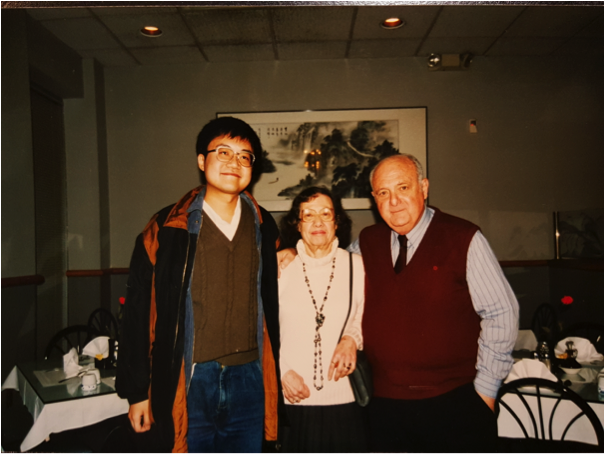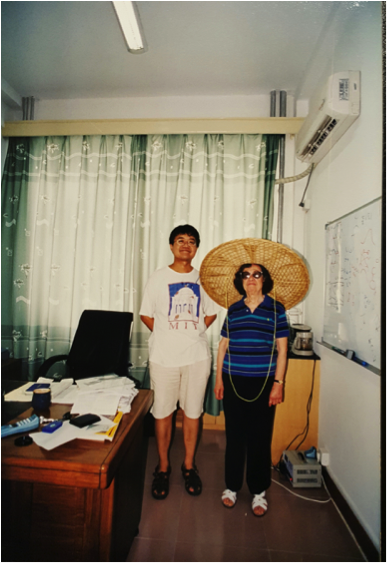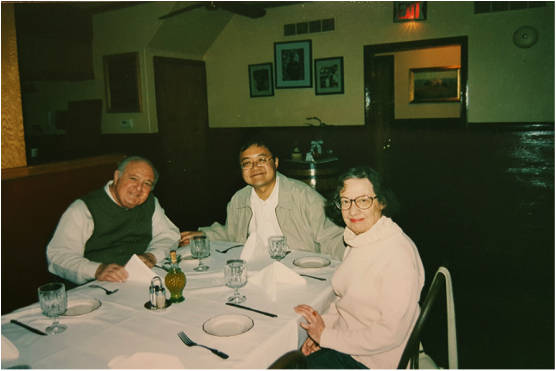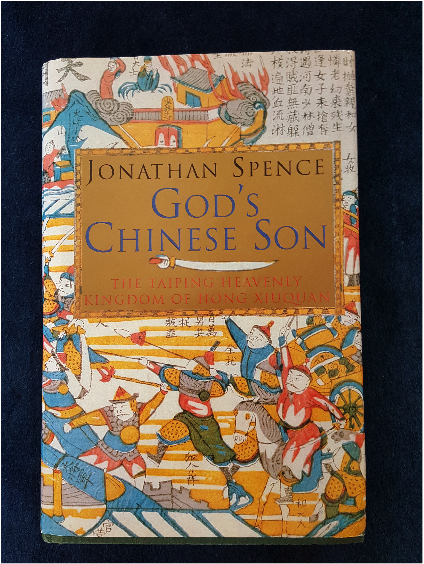 精选
精选
The Meaning of Life
Ming-Wei Wu
Department of Physics, University of Science and Technology of China, Hefei, Anhui, 230026, China
A speech delivered at Esther Conwell and Carlo Taliani memorial symposium of ICSM2016 on June 26, 2016
Esther Conwell is one of the three most important mentors in my academic career, the other two are my late father and Prof. Hartmut Haug in Germany. I knew Esther Conwell’s name from her pioneering book on hot-electron transport, when I was still a Ph. D student, as part of my Ph. D dissertation is on this topic. Later I heard from Prof. Xin Sun (who happened to be the Chairman of the ICSM2002 in Shanghai) that Prof. Esther Conwell was then working on conducting polymers. I was quite lucky to have the opportunity to work with her as a postdoc for one year. I really learned a lot from her. She had constantly been a strong supporter in my scientific career.
 photo taken in 1996 in Rochester, NY
photo taken in 1996 in Rochester, NY
I first met Esther in 1996, when I was a postdoc in the US, at the APS Marchmeeting in St Louis, where she gave an invited talk on conducting polymers. I was quite fascinated by her elegance and charm and decided that I would like to work with her. I did not have time to chat with her after her talk, but I wrote to her afterwards. Then she invited me for an interview. This photo was taken at that time. I was quite young back then. After the interview, Esther took me to an Italian restaurant. Even though I am very fond of Italian spaghetti now, my first trial of the Americanized variety was not so successful.

photo taken in 1997 in Webster, NY
Then I worked with Esther from Sept., 1996 to Aug., 1997, until I moved to Frankfurt, Germany. During this period of time, we worked on charge transport in organic materials and photoinduced charge transfer in weakly coupled donor-acceptor conjugated polymers. Altogether, we published 6 papers. Some were later well cited. I learned a great deal from the way Esther thought about physics and also from her devotion to science. Meanwhile, I think I managed to convince her to use the SSH Hamiltonian to describe transport in PPV, rather than taking the detailed property of the benzene ring, from the point of view of renormalization group. In comparison, all her prior works had to deal with complex band structure calculations. I am glad to see afterwards she also applied the SSH Hamiltonian to even more complex structures. During this period, Esther won the IEEE Edison Golden medal for lifetime achievement. I still remember how nonchalantly she reacted to the compliments: during the award ceremony, instead of showing how she was flattered, she recalled how she was unfairly treated during her early career as the only female participant of IEEE conferences. She followed this with testimonies of how IEEE has been making good progress over the years in giving equal rights to female scientists. Then she simply ended her speech. I was quite amazed by her attitude.


photo taken in 2002 in Hefei, China
I returned back to China on Jan. 1, 2002. Esther visited me that summer, after she attended the ICSM2002 in Shanghai. She was 80 years old then. This photo was taken in my office. At that time, my newly purchased apartment was still being spruced up and was on the 6-th floor. Esther insisted to climb all the way upto see the apartment as she told me that would be her only chance to visit my home. She also wanted to give me some house warming presents so that I would remember her. She was initially thinking about some cooking wares. But I suggested I would prefer a painting from her house. So she sent me this reprint of a Kandinsky, which still hangs in our living room.

photo taken in 2003 in Webster, NY
I visited Esther again in 2003, during my 3-month visit to the University of Delaware. This photo was taken during this visit, with her husband Abe, who was a writer. His attitude towards my returning to China and my view of the possible future seemed to be quite reserved. I think he tried to hint at something by giving me the book, God’s Chinese Son, by Jonathan Spence. Unfortunately, I did not realize his implication at that time.


On May 22nd, 2008, my 40th birthday, Esther wrote to me, "I can't believe you are 40. That is even more incredible than that I will be 86 tomorrow. I still think of you as a young student. But your students must consider you 'over the hill', as we would say it in the U.S.” (Her birthday happened to be just one day after mine.) Indeed, things changed a lot after I became 40. I started to wonder about the meaning of life, and started to seek answers to the troubles around me by reading books by Karl R. Popper, Hannah Arendt (her idea of Banality of Evil really inspired me a lot), Vaclav Havel (I am quite encourged by his idea of Living in Truth), Adam Michnik (Samizdat), etc.

I took this photo by iphone in 2012 in her office in Webster, NY
This led to the question during my last visit with her on my way to the APS March meeting in 2012: What do you think of the meaning of life? She was 90 years old then and was still trying to recover from the loss of her husband Abe. She was still working on the problem of charge transport in DNA. For the very first time, she said to me: I am old now. Here is her answer to my question: Being a Woman, all my lifetime, I have been working hard in order to survive in the scientific society. So I did not have time to think about it. When we meet next time, I will tell you how I think. I promised to visit her again during my next US trip. Unfortunately I never had such a chance and will never have the chance in this world to listen to her answer to my question. Maybe one day, when I meet her in another world, she will tell me how she thinks. However, somehow, even in this world, she may have already revealed the meaning of life to me, through her lifetime pursuing of the best physics one may think of.
转载本文请联系原作者获取授权,同时请注明本文来自吴明卫科学网博客。
链接地址:https://wap.sciencenet.cn/blog-244354-986945.html?mobile=1
收藏


